Development of a Resource Optimization Platform for Cross-Regional Operation and Maintenance Service for Combine Harvesters
Abstract
:1. Introduction
2. Analysis of Demand for a Cross-Regional Operation and Maintenance Service Platform for Harvesters
2.1. Research Background
2.2. Analysis of Requirements
3. System Design
3.1. Overall Design of the Platform
3.2. Functional Design of the Platform
3.3. Functional Architecture Design of the Platform
4. Platform Development of Key Technologies
4.1. Optimization Technology for the Resource Allocation of O&M Services
4.2. O&M Service Path Optimization Analysis Technology
5. O&M Service Platform Implementation
5.1. Development of Key Technologies for the Platform
5.2. Maintenance Service Activity Management System
5.3. List of Repair Service Activities and Detailed Interface
6. Platform Application Validation
6.1. Platform Architecture Performance Validation
6.2. Verification of Path Optimization in the Platform
7. Conclusions
Author Contributions
Funding
Institutional Review Board Statement
Informed Consent Statement
Data Availability Statement
Conflicts of Interest
References
- Chen, Z.-D.; Li, F.-B.; Xu, C.-C.; Ji, L.; Feng, J.-F.; Fang, F.-P. Spatial and temporal changes of paddy rice ecosystem services in China during the period 1980–2014. J. Integr. Agric. 2022, 21, 3082–3093. [Google Scholar] [CrossRef]
- Wang, Y.; Wang, H. Effects of farmland use rights transfer on collective action in the commons: Evidence from rural China. Land Use Policy 2022, 120, 106262. [Google Scholar] [CrossRef]
- Han, J.; Hu, Y.; Mao, M.; Wan, S. A multi-objective districting problem applied to agricultural machinery maintenance service network. Eur. J. Oper. Res. 2020, 287, 1120–1130. [Google Scholar] [CrossRef]
- Hu, Y.; Liu, Y.; Wang, Z.; Wen, J.; Li, J.; Lu, J. A two-stage dynamic capacity planning approach for agricultural machinery maintenance service with demand uncertainty. Biosyst. Eng. 2020, 190, 201–217. [Google Scholar] [CrossRef]
- Wysel, M.; Baker, D.; Billingsley, W. Data sharing platforms: How value is created from agricultural data. Agric. Syst. 2021, 193, 103241. [Google Scholar] [CrossRef]
- Cao, Y.; Yi, C.; Wan, G.; Hu, H.; Li, Q.; Wang, S. An analysis on the role of blockchain-based platforms in agricultural supply chains. Transp. Res. Part E Logist. Transp. Rev. 2022, 163, 102731. [Google Scholar] [CrossRef]
- Nikkilä, R.; Seilonen, I.; Koskinen, K. Software architecture for farm management information systems in precision agriculture. Comput. Electron. Agric. 2010, 70, 328–336. [Google Scholar] [CrossRef]
- Daum, T.; Villalba, R.; Anidi, O.; Mayienga, S.M.; Gupta, S.; Birner, R. Uber for tractors? Opportunities and challenges of digital tools for tractor hire in India and Nigeria. World Dev. 2021, 144, 105480. [Google Scholar] [CrossRef]
- Cao, R.; Li, S.; Ji, Y.; Zhang, Z.; Xu, H.; Zhang, M.; Li, M.; Li, H. Task assignment of multiple agricultural machinery cooperation based on improved ant colony algorithm. Comput. Electron. Agric. 2021, 182, 105993. [Google Scholar] [CrossRef]
- Schut, M.; Klerkx, L.; Kamanda, J.; Sartas, M.; Leeuwis, C. Innovation Platforms: Synopsis of Innovation Platforms in Agricultural Research and Development. In Encyclopedia of Food Security and Sustainability; Ferranti, P., Berry, E.M., Anderson, J.R., Eds.; Elsevier: Oxford, UK, 2019; pp. 510–515. [Google Scholar]
- Popović, T.; Latinović, N.; Pešić, A.; Zečević, Ž.; Krstajić, B.; Djukanović, S. Architecting an IoT-enabled platform for precision agriculture and ecological monitoring: A case study. Comput. Electron. Agric. 2017, 140, 255–265. [Google Scholar] [CrossRef]
- Barmpounakis, S.; Kaloxylos, A.; Groumas, A.; Katsikas, L.; Sarris, V.; Dimtsa, K.; Fournier, F.; Antoniou, E.; Alonistioti, N.; Wolfert, S. Management and control applications in Agriculture domain via a Future Internet Business-to-Business platform. Inf. Process. Agric. 2015, 2, 51–63. [Google Scholar] [CrossRef]
- Bochtis, D.; Sørensen, C.A.G.; Kateris, D. 9-Advances and Future Trends in Agricultural Machinery and Management. In Operations Management in Agriculture; Bochtis, D., Sørensen, C.A.G., Kateris, D., Eds.; Academic Press: Cambridge, MA, USA, 2019; pp. 197–208. [Google Scholar]
- Ren, W.; Wu, K.; Gu, Q.; Hu, Y. Intelligent decision making for service providers selection in maintenance service network: An adaptive fuzzy-neuro approach. Knowl. Based Syst. 2020, 190, 105263. [Google Scholar] [CrossRef]
- Mourtzis, D.; Angelopoulos, J.; Panopoulos, N. Design and Development of an Edge-Computing Platform Towards 5G Technology Adoption for Improving Equipment Predictive Maintenance. Procedia Comput. Sci. 2022, 200, 611–619. [Google Scholar] [CrossRef]
- Liu, K. GIS-based MCDM framework combined with coupled multi-hazard assessment for site selection of post-earthquake emergency medical service facilities in Wenchuan, China. Int. J. Disaster Risk Reduct. 2022, 73, 102873. [Google Scholar] [CrossRef]
- Wang, L.; Ma, Y.; Zhu, L.; Wang, X.; Cong, H.; Shi, T. Design of integrated energy market cloud service platform based on blockchain smart contract. Int. J. Electr. Power Energy Syst. 2022, 135, 107515. [Google Scholar] [CrossRef]
- Zhao, S.; Zhu, S.; Wu, Z.; Jaing, B. Cooperative energy dispatch of smart building cluster based on smart contracts. Int. J. Electr. Power Energy Syst. 2022, 138, 107896. [Google Scholar] [CrossRef]
- Kieti, J.; Waema, T.M.; Ndemo, E.B.; Omwansa, T.K.; Baumüller, H. Sources of value creation in aggregator platforms for digital services in agriculture-insights from likely users in Kenya. Digit. Bus. 2021, 1, 100007. [Google Scholar] [CrossRef]
- Kaloxylos, A.; Groumas, A.; Sarris, V.; Katsikas, L.; Magdalinos, P.; Antoniou, E.; Politopoulou, Z.; Wolfert, S.; Brewster, C.; Eigenmann, R.; et al. A cloud-based Farm Management System: Architecture and implementation. Comput. Electron. Agric. 2014, 100, 168–179. [Google Scholar] [CrossRef]
- Antle, J.M.; Basso, B.; Conant, R.T.; Godfray, H.C.J.; Jones, J.W.; Herrero, M.; Howitt, R.E.; Keating, B.A.; Munoz-Carpena, R.; Rosenzweig, C.; et al. Towards a new generation of agricultural system data, models and knowledge products: Design and improvement. Agric. Syst. 2017, 155, 255–268. [Google Scholar]
- Kang, Y.; Pan, L.; Liu, S. Job scheduling for big data analytical applications in clouds: A taxonomy study. Future Gener. Comput. Syst. 2022, 135, 129–145. [Google Scholar] [CrossRef]
- Kolling, C.; de Medeiros, J.F.; Duarte Ribeiro, J.L.; Morea, D. A conceptual model to support sustainable Product-Service System implementation in the Brazilian agricultural machinery industry. J. Clean. Prod. 2022, 355, 131733. [Google Scholar] [CrossRef]
- Zambrano, V.; Mueller-Roemer, J.; Sandberg, M.; Talasila, P.; Zanin, D.; Larsen, P.G.; Loeschner, E.; Thronicke, W.; Pietraroia, D.; Landolfi, G.; et al. Industrial digitalization in the industry 4.0 era: Classification, reuse and authoring of digital models on Digital Twin platforms. Array 2022, 14, 100176. [Google Scholar]
- Hsu, T.-C.; Yang, H.; Chung, Y.-C.; Hsu, C.-H. A Creative IoT agriculture platform for cloud fog computing. Sustain. Comput. Inform. Syst. 2020, 28, 100285. [Google Scholar] [CrossRef]
- Sinha, B.B.; Dhanalakshmi, R. Recent advancements and challenges of Internet of Things in smart agriculture: A survey. Future Gener. Comput. Syst. 2022, 126, 169–184. [Google Scholar] [CrossRef]
- Liu, J.; Yang, T.; Bai, J.; Sun, B. Resource allocation and scheduling in the intelligent edge computing context. Future Gener. Comput. Syst. 2021, 121, 48–53. [Google Scholar] [CrossRef]
- Zongyi, Z.; Shanming, Q.; Meng, Z. Spatial flow law of cross-regional operation of wheat combine harvesters in China. Trans. Chin. Soc. Agric. Eng. 2021, 37, 19–27. [Google Scholar]
- Caicong, W.; Ying, C.; Weizhong, Y.; Lili, Y.; Peng, Q.; Qin, M.; Weixin, Z.; Dong, L.; Xiaoqiang, Z.; Chuanfeng, W.; et al. Construction of big data system of agricultural machinery based on BeiDou. Trans. Chin. Soc. Agric. Eng. 2022, 38, 1–8. [Google Scholar]
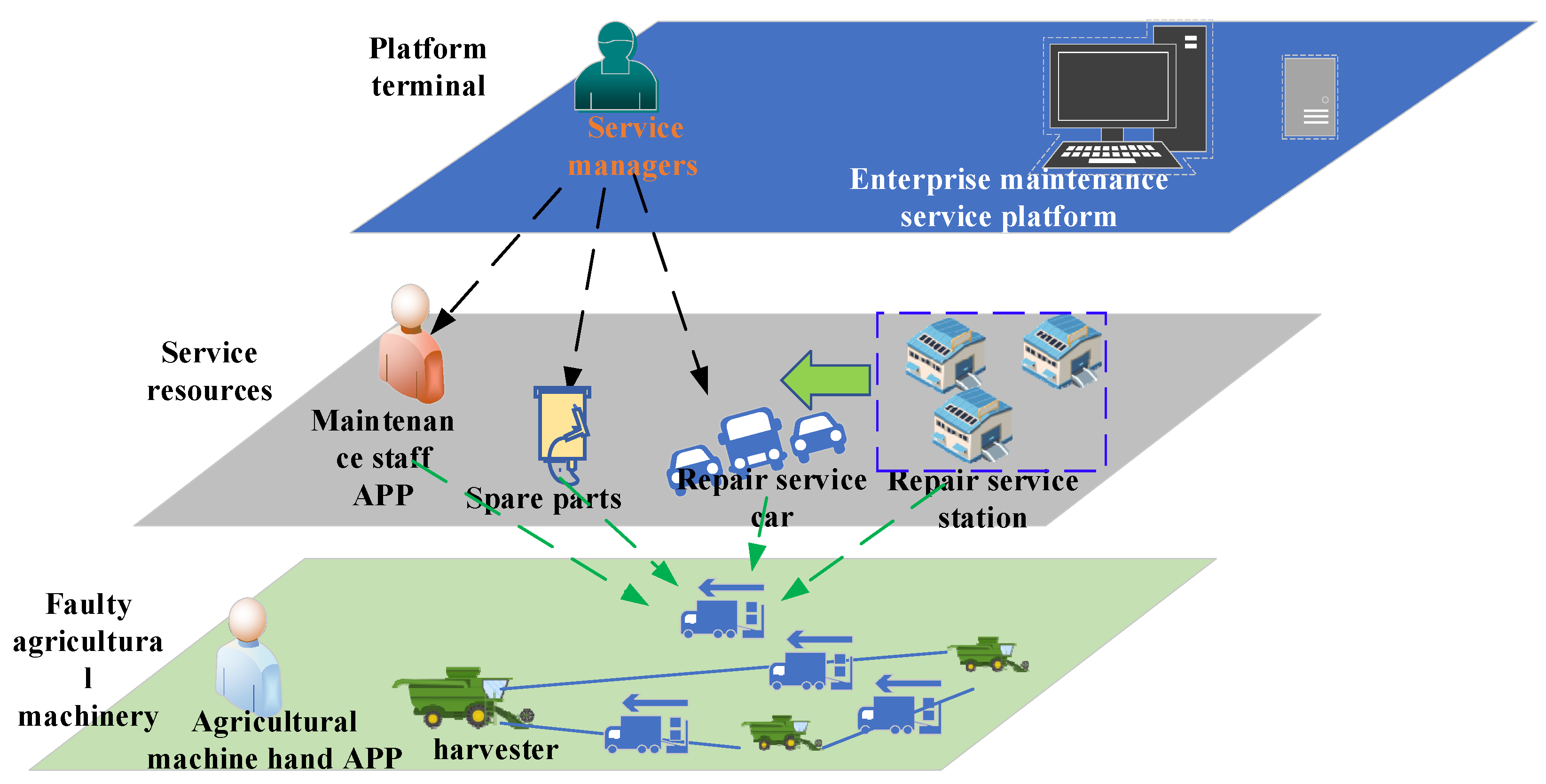
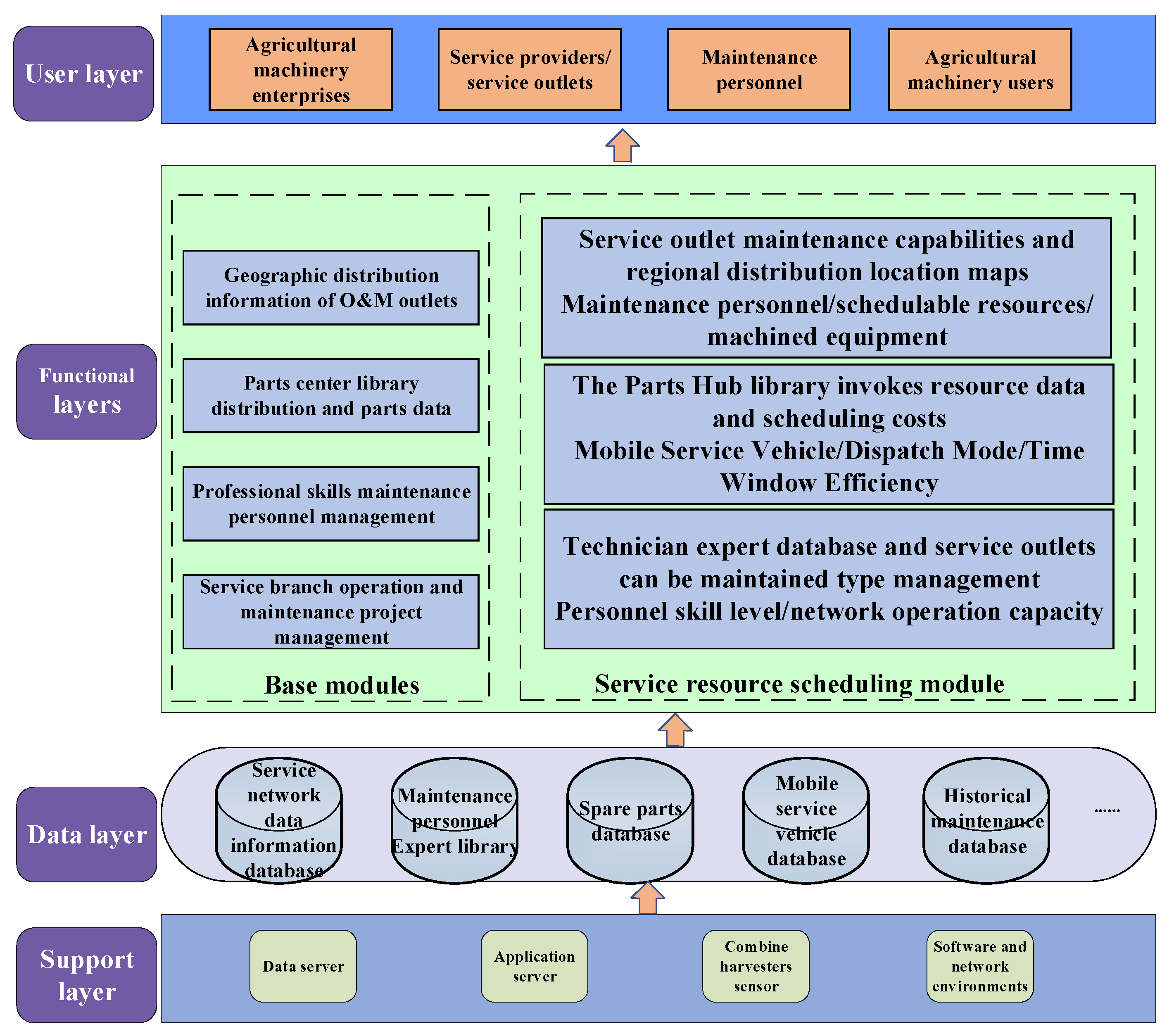
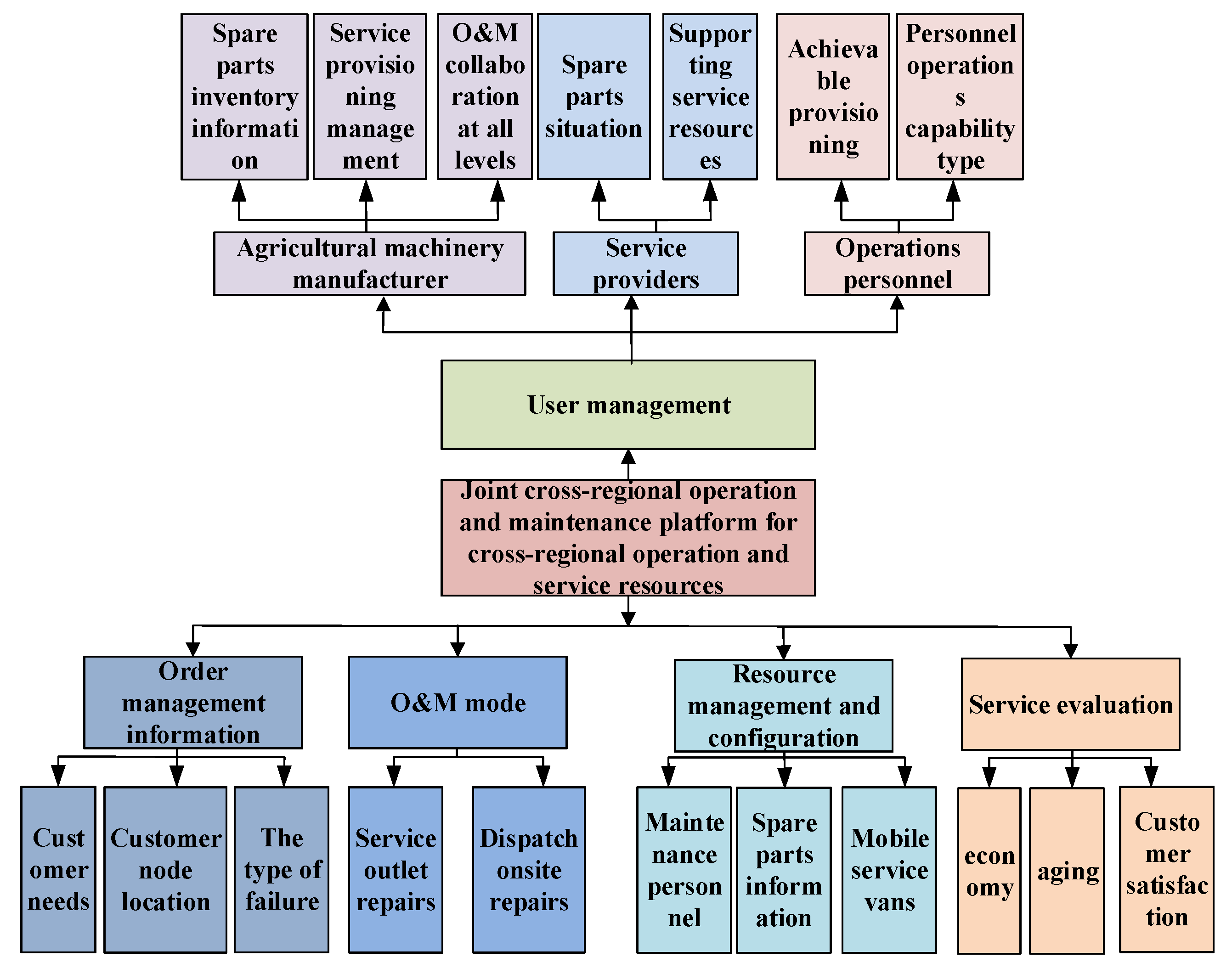
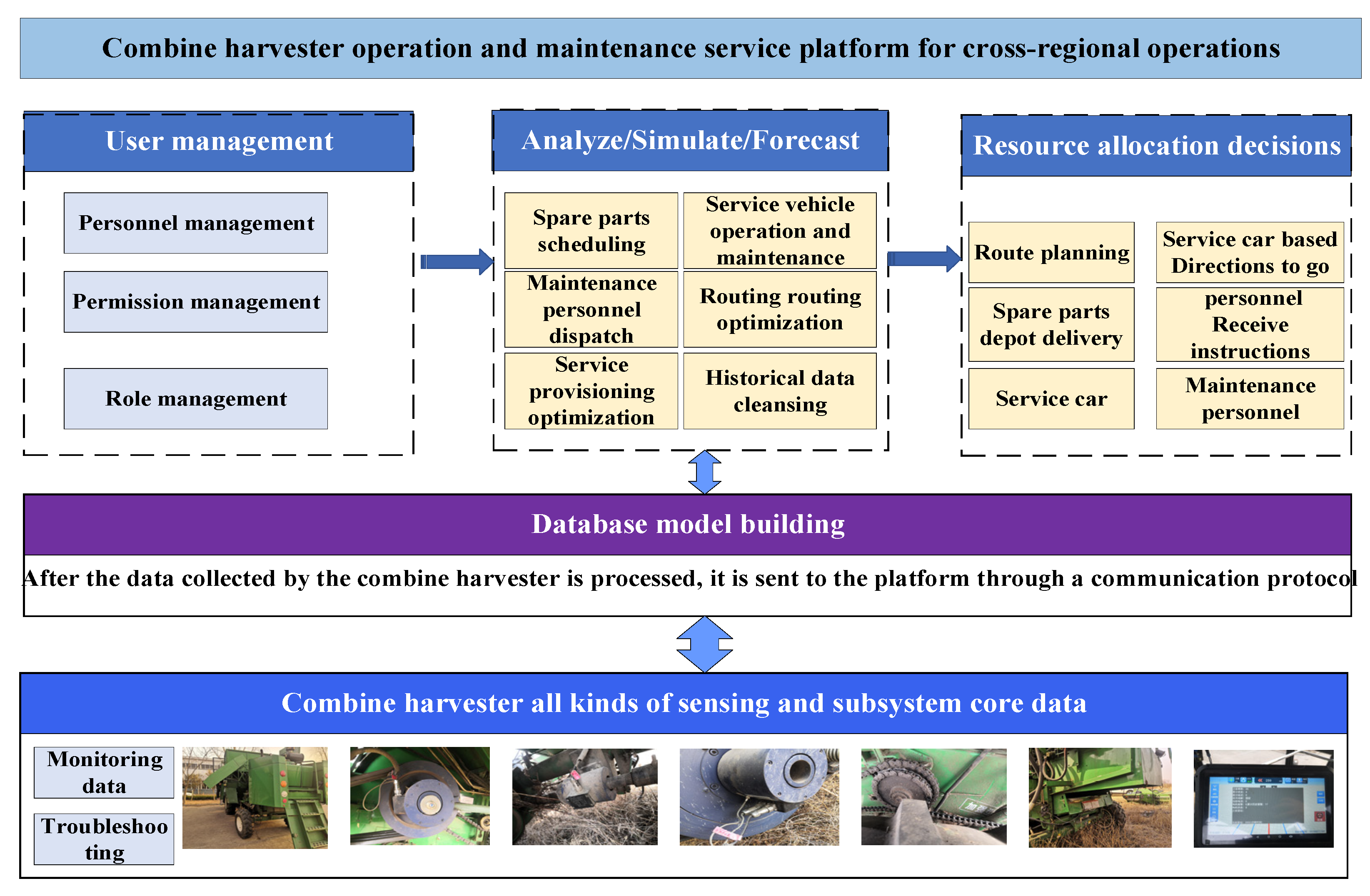





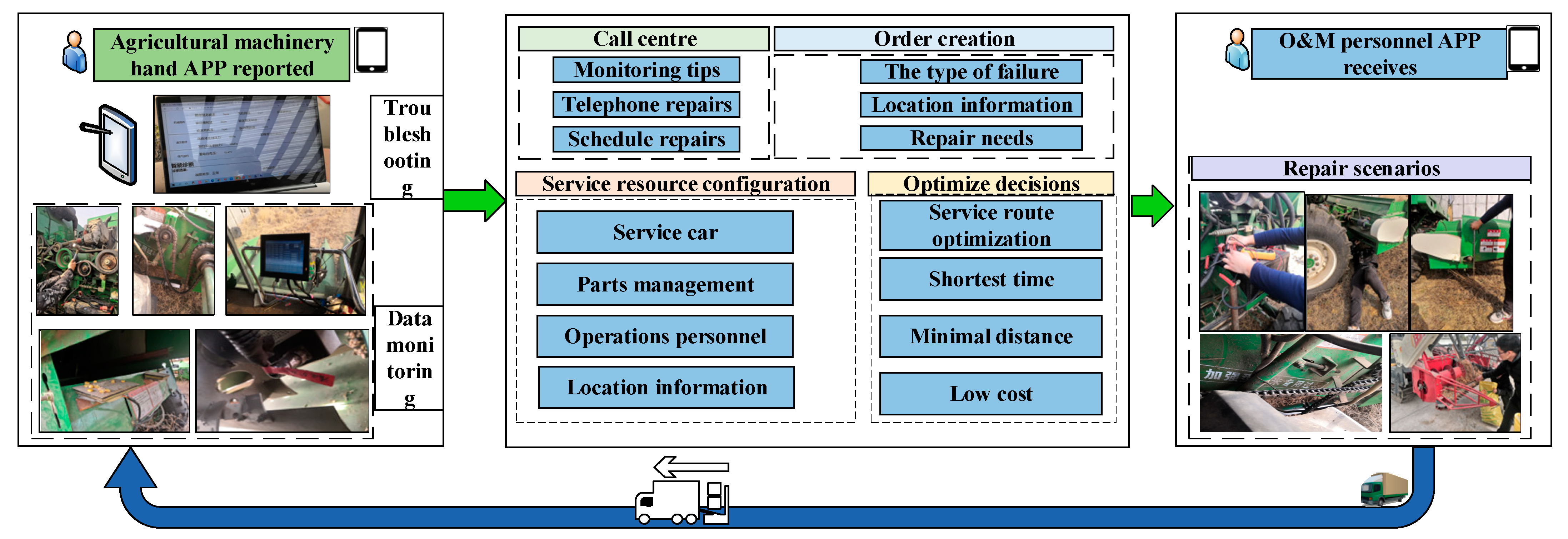


| Type of Agricultural Dispatch Platform | System Function | Source in Literature |
|---|---|---|
| Farm management system platform | The adoption of the new agricultural system model created a market for services and applications available to farmers. | [20,21] |
| Agricultural machinery dispatching system platform | Job scheduling method can be carried out through the system platform. | [22,23,24] |
| Agricultural Internet of Things platform | Realized the networking management and control of each module in the new agricultural scene. | [25,26,27] |
| Architecture | Cross-Platform | Safety | Maintain | Responding Speed |
|---|---|---|---|---|
| B/S | good | poor | easy | slow |
| C/S | poor | good | difficulty | quick |
| Layer 2 C/S | good | poor | easy | faster |
| Layer 3 C/S | good | good | easy | faster |
| Node | Dijkstra’s Algorithm | A* Algorithm |
|---|---|---|
| 32 | 4 s | 4 s |
| 40 | 7 s | 6 s |
| 63 | 16 s | 8 s |
| 77 | 24 s | 11 s |
| Node | Dijkstra’s Algorithm | A* Algorithm |
|---|---|---|
| 32 | 31 (100%) | 25 (80.65%) |
| 40 | 39 (100%) | 31 (79.49%) |
| 63 | 60 (96.77%) | 39 (62.90%) |
| 77 | 75 (98.68%) | 44 (57.89%) |
Publisher’s Note: MDPI stays neutral with regard to jurisdictional claims in published maps and institutional affiliations. |
© 2022 by the authors. Licensee MDPI, Basel, Switzerland. This article is an open access article distributed under the terms and conditions of the Creative Commons Attribution (CC BY) license (https://creativecommons.org/licenses/by/4.0/).
Share and Cite
Zhang, W.; Zhao, B.; Zhou, L.; Qiu, C.; Wang, J.; Niu, K.; Jiang, H.; Li, Y. Development of a Resource Optimization Platform for Cross-Regional Operation and Maintenance Service for Combine Harvesters. Appl. Sci. 2022, 12, 9873. https://doi.org/10.3390/app12199873
Zhang W, Zhao B, Zhou L, Qiu C, Wang J, Niu K, Jiang H, Li Y. Development of a Resource Optimization Platform for Cross-Regional Operation and Maintenance Service for Combine Harvesters. Applied Sciences. 2022; 12(19):9873. https://doi.org/10.3390/app12199873
Chicago/Turabian StyleZhang, Weipeng, Bo Zhao, Liming Zhou, Conghui Qiu, Jizhong Wang, Kang Niu, Hanlu Jiang, and Yashuo Li. 2022. "Development of a Resource Optimization Platform for Cross-Regional Operation and Maintenance Service for Combine Harvesters" Applied Sciences 12, no. 19: 9873. https://doi.org/10.3390/app12199873





